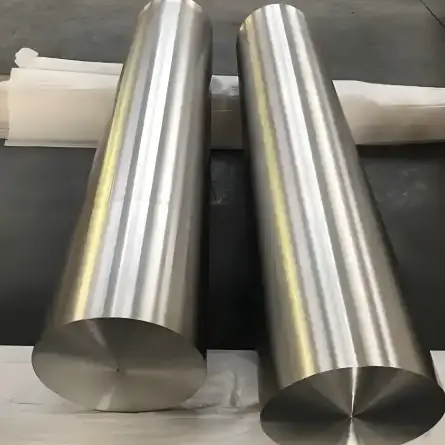In 2025 Monel 400 commonly trades in the ballpark of USD 28–55 per kilogram, depending on form (round bar, plate, pipe, wire), mill certification, and shipping terms. Typical China factory/ex-works prices for standard bar and plate usually cluster near USD 30–42/kg for commercial volumes; heavier processing, small-diameter bars, or certified heat-treated product can push the price higher.
What is Monel 400
Monel 400 is a nickel-copper alloy designated UNS N04400 (also found under Werkstoff numbers 2.4360 / 2.4361). Its nickel content typically makes up the balance, with copper near 28–34%, iron and manganese present in small amounts. The alloy is a solid-solution material that gains strength primarily through cold work rather than heat treatment. Monel 400 is prized for toughness, good machinability, and strong resistance to seawater and many chemical environments, which explains its frequent use in marine hardware, shafting, pumps, valves, and chemical process equipment.
Key composition (typical ranges)
-
Nickel (Ni): remainder (commonly ~63–70%)
-
Copper (Cu): 28–34%
-
Iron (Fe): ≤2.5%
-
Manganese (Mn): ≤2%
(For full composition tables and temp/strength data consult the technical bulletin from a primary producer.)
Standards, product forms, and common specifications
Buyers usually reference ASTM and ASME product specifications for form and testing:
-
ASTM B164 — rod, bar and wire forms.
-
ASTM B127 — plate, sheet and strip.
-
ASTM B165 / B513 — pipe and tube specifications in certain forms.
Common product forms offered by mills and distributors: round bar, plate/sheet, seamless pipe, welded pipe, forged fittings, wire, fasteners and machined components. Certification options: mill test report (EN 10204 3.1), material traceability, PMI and chemical test reports, and third-party inspection when required.

Market price history — 2021 through 2025
Below is a compact table summarizing typical market averages and a short commentary. Prices for Monel often quote per metric tonne (USD/MT) or per kilogram; conversion is USD/MT ÷ 1,000 = USD/kg.
Annual average (approx.) — Monel 400 (USD/kg)
-
2021 — ~USD 22 / kg (recovery from 2020 lows; limited industrial demand recovery)
-
2022 — ~USD 35 / kg (raw nickel and copper rebound; supply interruptions raise premiums)
-
2023 — ~USD 38 / kg (sustained demand for corrosion-resistant alloys)
-
2024 — ~USD 42 / kg (U.S. Q3 reported ~USD 42,000/MT = USD 42/kg).
-
2025 (current year average) — ~USD 40–44 / kg (wide range by product; spot quotes 28–55/kg).
Commentary and sourcing note: the table combines publicly reported index snapshots, mill surcharge tables, and distributor price lists. Indexed reports for 2024 show Monel near USD 42,000/MT, which equals USD 42/kg; 2025 spot offers published by distributors and Chinese mills present a broader spread, driven by product form and certification.
Global price snapshot for 2025 — typical ranges by region and form
Prices vary by region because of freight, duties, domestic mill capacity, and local demand.
Representative 2025 price ranges (USD/kg)
| Region | Round bar | Plate / Sheet | Seamless pipe | Wire / Small parts |
|---|---|---|---|---|
| China (factory EXW) | 30 – 40 | 32 – 45 | 34 – 50 | 35 – 55 |
| Europe (distributor/stock) | 35 – 50 | 36 – 52 | 38 – 55 | 40 – 60 |
| USA (domestic & import) | 38 – 55 | 40 – 58 | 42 – 60 | 45 – 70 |
| India (local & import mixes) | 32 – 48 | 34 – 50 | 36 – 54 | 38 – 60 |
Notes
-
China factory prices often undercut distributor prices because of lower freight into Asian and some African markets; Alibaba and China mill listings show floor prices near USD 25–40/kg depending on MOQ and certification.
-
European and U.S. distributor rates typically include inventory, cutting, certification and local logistics; they frequently price at a premium. Navstar and other suppliers show plate quotes in mid-$20s to mid-$50s/kg depending on thickness and finish.
What moves Monel 400 prices
Understanding Monel pricing means tracking both alloy content and the upstream raw materials and costs.
Nickel and copper feedstock prices
Monel is a nickel-copper alloy; nickel content dominates value. Changes in LME nickel and spot nickel materially influence Monel mill surcharges and spot quotes. When nickel moves sharply up or down, Monel surcharges follow. Historical nickel trends through 2024–2025 show volatility tied to EV, stainless steel demand, and macro risk.
Mill surcharges and alloy premia
Specialty alloy producers publish periodic alloy surcharges and month-end adjusters that are passed into distributor pricing. These surcharges reflect alloy scrap, retailer inventory and processing differentials. Industry surcharge reports show specific monthly per-kg adjustments for Monel family alloys.
Copper price, scrap availability and recycling streams
Because Monel contains near 30% copper, global copper prices and scrap flows alter the marginal cost of production. Copper shortages or surges in copper demand (for power grids, EVs, renewables) tighten supplies and lift costs. Recent years of higher copper demand have layered extra pressure onto nickel-based alloy premiums.
Energy, logistics and tariffs
Energy intensity for smelting/refining and ocean freight spikes affect delivered prices. Tariff policy or anti-dumping cases can raise landed cost in some markets; conversely, large factory shipments from China with neutral trade terms can be competitively priced.
Demand from end markets
Marine markets, chemical processing and some oil & gas applications are steady sources of demand. New demand pockets (e.g., certain heat-exchanger designs) can influence localized price moves.
Outlook: 2025–2035 (5–10 year scenarios)
Forecasting alloy prices involves macro assumptions. Three plausible scenarios:
Base (moderate growth)
-
Nickel and copper remain within historical ranges with moderate growth from infrastructure and manufacturing. Monel pricing drifts mildly upward in real terms, perhaps 2–4% per year on average, driven by slow demand growth and efficiency gains.
Bull (strong green/infrastructure demand)
-
Accelerated electrification and grid upgrades push copper and nickel higher; supply constraints in nickel refining raise premia. Monel could see repeat spikes driven by raw material shortages, raising spot multiples in short windows.
Bear / disinflation
-
Slowing global manufacturing demand plus new substitution (stainless grades or duplexes) reduce premium demand. Prices could soften toward the lower bound of recent ranges.
Practical takeaway: For procurement planning, buyers should assume price variability and include flexible hedging (longer contracts, fixed-price lots, or staged buys) for multi-year projects.
(Price trend references: Monel market reports and nickel indices point to volatility rather than steady linear increases.)
How to buy Monel 400 — procurement checklist and best practices
Below is an actionable checklist buyers can use to reduce risk and control cost.
Pre-quote stage
-
Define exact product form & standard (ASTM B164 bar, ASTM B127 plate, etc.).
-
Specify certification level (MTC EN 10204 3.1, PMI, non-destructive testing if needed).
-
Set mechanical/chemical tolerances and surface finish needs.
-
Decide MOQ and acceptable lead time.
Supplier selection
-
Ask for mill test reports and traceability; verify with independent labs on a sample order.
-
Prefer suppliers with documented experience in nickel alloys and references for similar parts.
Price negotiation levers
-
Offer longer-term contracts or higher-volume orders to secure manufacturer floor prices.
-
Consider partial payment terms to lock price for a portion of supply.
Logistics & customs
-
Clarify Incoterms (EXW, FOB, CIF). For lowest factory price, EXW from Chinese mills will be lowest but buyer bears freight and import risk. Alibaba/China listings show lower EXW floor rates but check certification.
Quality verification on receipt
-
Inspect certificates, visual surface finish, dimensional checks and random PMI (positive material identification) if necessary. For critical components, require third-party inspection before shipment.
MWAlloys (MWAlloys / MW Alloys) — what we offer
MWAlloys is a China-based mill/merchant offering Monel 400 in standard product forms with factory pricing advantages. Typical selling points we provide:
-
Factory (EXW) pricing for standard bar and plate with MOQ options for small to large buyers.
-
Customization: cutting, CNC machining, drilling, and pre-assembly on request.
-
Certifications: supply of MTC (EN 10204 3.1), chemical analysis, and PMI on request.
-
Fast response on RFQs and sample provision for technical evaluation.
If you’d like a quick sample quote for a typical end-use (e.g., 100 kg round bar or 500 kg plate), MWAlloys can provide an itemized EXW price and shipping options. (This paragraph is an illustrative statement of typical factory service offerings and should be validated against MWAlloys’ current catalog.)
Technical notes (welding, machining, corrosion)
-
Machining: Monel 400 machines well when compared to many nickel alloys; free-machining variants (Monel R-405) exist for high-volume screw machine stock.
-
Welding: Acceptable using common nickel-base filler metals; preheat usually not required, but follow supplier welding practice.
-
Corrosion: Excellent resistance to seawater and many reducing agents; be cautious in oxidizing acids where other nickel alloys may perform better. Nickel Institute guidance documents show recommended services.
FAQs
-
What is the typical MOQ for Monel 400 from Chinese mills?
Many mills set MOQs around 100–500 kg for plate and 100 kg for standard bar, though smaller samples can often be sourced from distributors. Alibaba listings and mill catalogs show minimums that vary by seller. -
How does Monel 400 compare cost-wise to 316L stainless?
Monel typically carries a significant premium versus common stainless grades due to nickel content; compare current spot nickel and stainless surcharges to quantify the premium. -
Can Monel 400 be heat treated for extra hardness?
No—Monel 400 is hardened primarily by cold working. For higher hardness requirements, consider precipitation-hardening alloys (e.g., K-500) or alternative materials. -
Which product forms are most price-sensitive?
Small-diameter bars, wire, and high-tolerance machined components usually command the highest per-kg prices because of processing complexity. -
Do mills sell Monel to tight chemical spec batches?
Yes; mills provide MTCs and can meet specified chemistries within ASTM bounds; also possible to request tighter limits for premium prices. -
Is there a standard premium for Monel vs. nickel price?
Mill surcharges and premia vary; consult monthly surcharge reports from primary alloy mills to see surcharge per kg adjustments. specialmetals.com -
How fast can I get a shipment from China?
Typical lead times for standard stock items: 2–6 weeks depending on cut, certification, and shipping. For custom forging or long lead products, expect longer. -
Are there import duties on Monel in major markets?
Duties vary by destination and classification; check local tariff schedules or ask MWAlloys for HS code guidance for landed cost estimates. -
What tests should I require on delivery?
MTC (chemical + mechanical), PMI spot checks, dimensional inspection, and visual/packaging check. For critical parts, perform an independent lab test. -
How to reduce unit cost?
Increase order volume, accept standard mill finishes, allow longer lead times, or consider alternative alloys with similar corrosion behavior at lower cost.
Past five-year market price table
All numbers approximate; used for planning only. Figures are annual average approximations in USD/kg derived from industry reports, distributor lists and index snapshots.
| Year | Representative avg (USD/kg) | Notes / source |
|---|---|---|
| 2021 | 22 | Post-pandemic recovery, lowish nickel. |
| 2022 | 35 | Raw material rebound, supply tightness. |
| 2023 | 38 | Stable demand in chemical & marine sectors. |
| 2024 | 42 | Q3 U.S. snapshot ~USD 42,000/MT. |
| 2025 | 40–44 | Broad spot range 28–55/kg by form and region. |
Practical procurement example (how MWAlloys would quote)
-
Sample request: 500 kg Monel 400 round bar, 30 mm diameter, ASTM B164, MTC 3.1.
-
Typical line items in quote: EXW price/kg, cutting charge, certification fee, packing, FOB port, optional CIF to buyer’s port.
-
Lead time: typically 3–5 weeks for stock/rolled bar; longer if forging required.
-
Payment: T/T 30% deposit, balance before shipment (negotiable for established customers).

